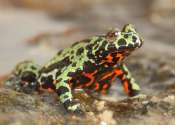Earliest example of a rapid-fire tongue found in 'weird and wonderful' extinct amphibians
Fossils of bizarre, armored amphibians known as albanerpetontids provide the oldest evidence of a slingshot-style tongue, a new Science study shows.

Fossils of bizarre, armored amphibians known as albanerpetontids provide the oldest evidence of a slingshot-style tongue, a new Science study shows.
Archaeology
Nov 5, 2020
0
263

An international study led by The Australian National University (ANU) has found a fungal disease has caused dramatic population declines in more than 500 amphibian species, including 90 extinctions, over the past 50 years.
Ecology
Mar 28, 2019
1
618

A deadly fungus responsible for the devastation of amphibian populations around the world may have originated in East Asia, new research has found.
Plants & Animals
May 10, 2018
0
98

Researchers have determined that the fossils of an extinct species from the Triassic Period are the long-missing link that connects Kermit the Frog's amphibian brethren to wormlike creatures with a backbone and two rows of ...
Paleontology & Fossils
Jun 19, 2017
2
219

(Phys.org) —One of the biggest threats facing amphibian species is the disease chytridiomycosis, which is caused by a fungus known as Batrachochytrium dendrobatidis (Bd). An understanding of the evolutionary history of ...

(Phys.org)—A team of US biologists has found that the chytrid fungus, believed to be responsible for amphibian deaths worldwide, also infects and kills crayfish. In their paper published in the Proceedings of the National ...

Some 165 million years ago, the world was host to a diversity of sounds. Primitive bushcrickets and croaking amphibians were among the first animals to produce loud sounds by stridulation (rubbing certain body parts together). ...
Archaeology
Feb 6, 2012
3
0

There's a crisis among the world's amphibians -- about 40 percent of amphibian species have dwindled in numbers in just three decades. Now, museum jars stuffed full of amphibians may help scientists decide whether this wave ...
Plants & Animals
May 2, 2011
1
0

(PhysOrg.com) -- Scientists have long been intrigued by the longevity of a tiny amphibian known as the blind salamander, but it now seems it may live a long time because it basically has no life.

A major survey of lizard populations worldwide has found an alarming pattern of population extinctions attributable to rising temperatures. If current trends continue, 20 percent of all lizard species could go extinct by ...
Plants & Animals
May 13, 2010
5
0
Order Temnospondyli - extinct Subclass Lepospondyli - extinct Subclass Lissamphibia Order Anura Order Caudata Order Gymnophiona
Amphibians (class Amphibia), such as frogs, toads, salamanders, newts, and caecilians, are ectothermic (or cold-blooded) animals that metamorphose from a juvenile water-breathing form, to an adult air-breathing form. Though amphibians typically have four limbs, the Caecilians are notable for being limbless. Unlike other land animals (amniotes), amphibians lay eggs in water. Amphibians are superficially similar to reptiles.
Amphibians are ecological indicators, and in recent decades there has been a dramatic decline in amphibian populations around the globe. Many species are now threatened or extinct.
Amphibians evolved in the Devonian Period and were top predators in the Carboniferous and Permian Periods, but many lineages were wiped out during the Permian-Triassic extinction. One group, the metoposaurs, remained important predators during the Triassic, but as the world became drier during the Early Jurassic they died out, leaving a handful of relict temnospondyls like Koolasuchus and the modern orders of Lissamphibia.
This text uses material from Wikipedia, licensed under CC BY-SA